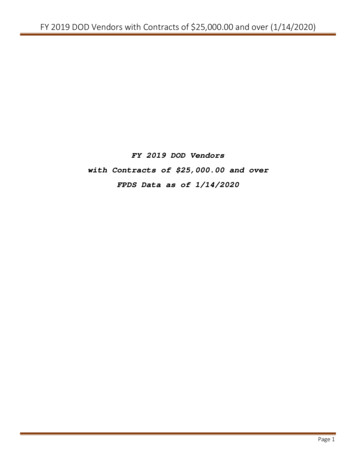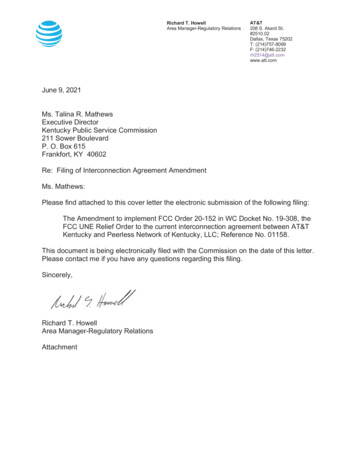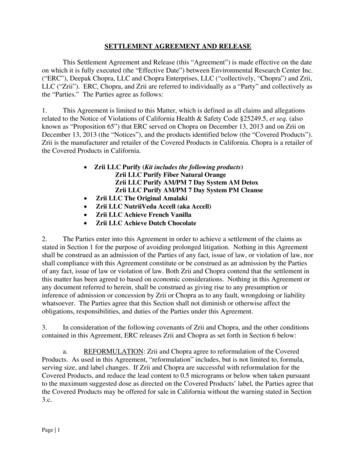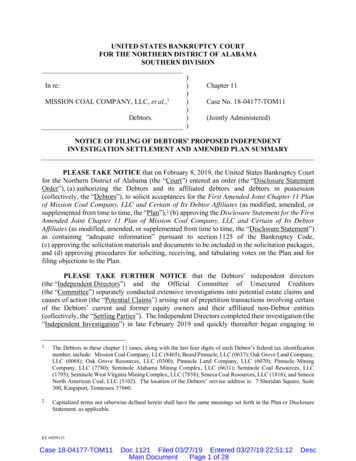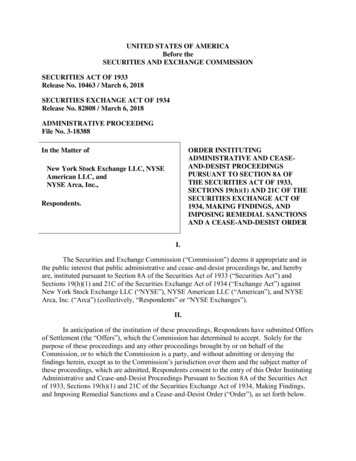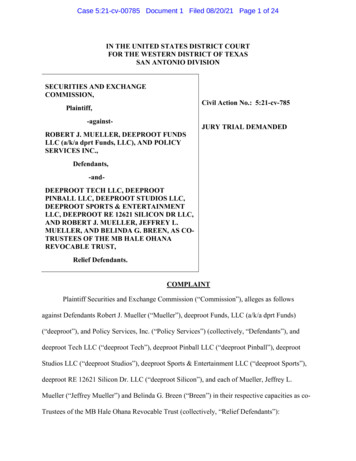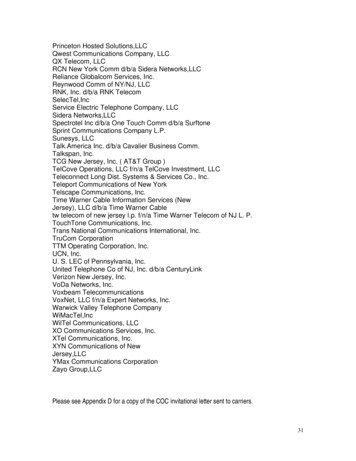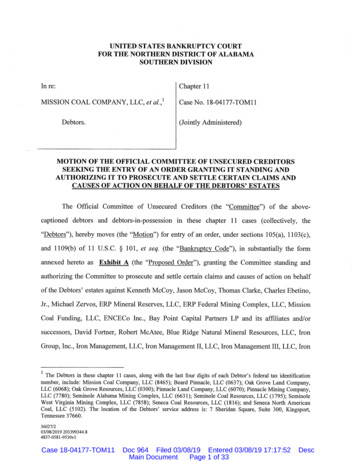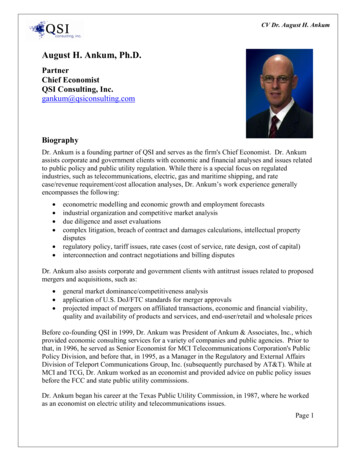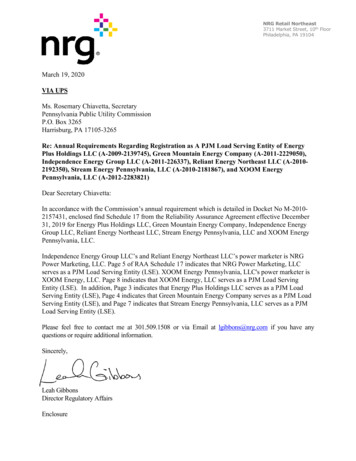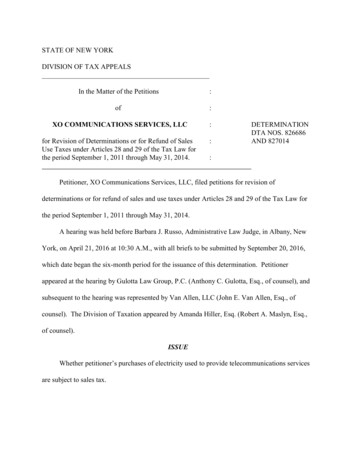
Transcription
STATE OF NEW YORKDIVISION OF TAX APPEALSIn the Matter of the Petitions:of:XO COMMUNICATIONS SERVICES, LLC:for Revision of Determinations or for Refund of SalesUse Taxes under Articles 28 and 29 of the Tax Law forthe period September 1, 2011 through May 31, 2014.:DETERMINATIONDTA NOS. 826686AND 827014:Petitioner, XO Communications Services, LLC, filed petitions for revision ofdeterminations or for refund of sales and use taxes under Articles 28 and 29 of the Tax Law forthe period September 1, 2011 through May 31, 2014.A hearing was held before Barbara J. Russo, Administrative Law Judge, in Albany, NewYork, on April 21, 2016 at 10:30 A.M., with all briefs to be submitted by September 20, 2016,which date began the six-month period for the issuance of this determination. Petitionerappeared at the hearing by Gulotta Law Group, P.C. (Anthony C. Gulotta, Esq., of counsel), andsubsequent to the hearing was represented by Van Allen, LLC (John E. Van Allen, Esq., ofcounsel). The Division of Taxation appeared by Amanda Hiller, Esq. (Robert A. Maslyn, Esq.,of counsel).ISSUEWhether petitioner’s purchases of electricity used to provide telecommunications servicesare subject to sales tax.
-2-FINDINGS OF FACT 11. Petitioner, XO Communications Services, LLC, is a national provider oftelecommunication services.22. Petitioner provides telecommunications services to small, medium and large businesses,as well as wholesalers and governmental entities such as public schools.3. Petitioner provides intrastate, interstate, and international telecommunication services.Petitioner used geocoding and service categories to determine and track the various categories oftelecommunication services provided.4. Petitioner filed two separate claims for refund of the sales tax it paid on its purchases ofelectricity. The first claim, assigned claim number 2013-11-0387 and dated November 11, 2013,requested a refund in the amount of 15,023.75, and pertained to petitioner’s purchases ofelectricity at its premises located at 32 Sixth Avenue, New York, New York, for the period May21, 2012 through July 5, 2013. The second claim, assigned claim number 2014-08-0255 anddated August 7, 2014, requested a refund in the amount of 1,108,350.21, and pertained topetitioner’s purchases of electricity at its premises located at 111 Eighth Avenue, 60 HudsonStreet, and 75 Broad Street, New York, New York, for the period September 1, 2011 throughMay 31, 2014.1Pursuant to State Administrative Procedure Act (SAPA) § 307(1), petitioner submitted 32 proposedfindings of fact. Petitioner’s proposed findings of fact 1, 2, 5 - 8, 10 - 14, 16, 17, 21 - 25, 27, and 31 are supportedby the record and have been consolidated, condensed, combined, renumbered and substantially incorporated herein.Petitioner’s proposed findings of fact 3, 4, 9, 15, 18 - 20, 26, 28 - 30 and 32 have been modified to more accuratelyreflect the record and remove conclusions of law. Additional Findings of Fact have been made.2Petitioner was formed as a result of the following transactions: on July 29, 1998, Nextlink New York,LLC merged and changed its name to Nextlink New York, Inc.; on September 27, 2000, Nextlink New York, Inc.,changed its name to XO New York, Inc.; on January 14, 2005, XO New York, Inc., merged into XOCommunications Services, Inc.; and on August 30, 2011, XO Communications Services, Inc., converted and changedits name to XO Communications Services, LLC. XO Communications, LLC is the sole member of XOCommunications Services, LLC.
-3-5. By letter dated January 6, 2014, the Division of Taxation (Division) denied the refundsought on claim number 2013-11-0387. By letter dated September 3, 2014, the Division deniedthe refund sought on claim number 2014-08-0255. The basis for the Division’s denials was thatthe electricity purchased was used by petitioner to provide telecommunication services, was notpurchased for resale and was not resold as such.6. Petitioner used the eighth floor of the building located at 32 Sixth Avenue, also knownas 32 Avenue of Americas, to house a “Central Office.” That Central Office is the subject ofDTA number 826686. Petitioner used the fifth and twelfth floors of the building located at 111Eighth Avenue, the ninth and thirteenth floors of the building located at 60 Hudson Street, andthe seventh floor of the building located at 75 Broad Street to house “Central Offices.” ThoseCentral Offices are the subject of DTA number 827014.7. Petitioner’s Central Offices house equipment used to provide interstate and intrastatetelecommunication services, including voice services, internet services, optical services andprivate data networks. Specifically, petitioner’s Central Offices contain voice switches thatprovide basic voice services, routers for voice and internet services, and long haul opticaltransport equipment to provide connectivity over a fiber optic network.8. The Central Office equipment is used to deliver services to the demarcation point. Atthe demarcation point, the service transfers to customer premise equipment (CPE). A commonexample of CPE is a router that can be purchased at a retail store.9. At the demarcation point, the electrical voltage flowing through the line can bemeasured. However, petitioner does not measure the voltage and current received at thecustomer location. Petitioner does not have a measurement of how much electricity eachcustomer used for each of the communication services.
-4-10. Petitioner also provides colocation services, whereby petitioner’s customers installtheir own equipment in petitioner’s facility. Under such arrangements, petitioner provides thephysical environment for the colocation customer’s equipment, including cooling and power tomaintain the equipment. Colocation services do not traverse over petitioner’s network.11. The electricity purchased by petitioner originates from power companies as alternatingcurrent (AC).12. The electricity then travels to meters located at petitioner’s Central Offices thatmeasure the total consumption of electricity. The electricity purchased in the form of AC wasused in petitioner’s Central Offices for purposes such as powering office systems and supportsystems, including providing cooling for equipment, powering the lights, computers, coffeemakers and other office equipment.13. Electricity flows from the meter to an automatic transfer switch, which senseselectricity flowing through it. If there is an interruption in the flow of electricity, the automatictransfer switch switches to a backup generator to provide electricity. Because there is a time lagfrom the interruption until the generators can produce adequate power, battery strings are used toprovide immediate, interim electricity.14. From the automatic transfer switch, electricity flows to the DC Power Plants, whichconvert AC to direct current (DC). As is the industry standard, petitioner’s Central Officenetwork electronics equipment operates off DC, and electricity from the DC Power Plants flowsto Central Office network electronics equipment and battery strings so that they remain charged.15. Administrative and colocation facilities located within the Central Offices operate offAC; therefore, electricity from DC Power Plants does not flow to them, except when power fromthe DC Power Plants stored in the battery strings is used for interim power.
-5-16. The DC Power Plants are metered so that petitioner can determine how muchelectricity flows through them. Petitioner reads the meter readings on a monthly basis. Thosereadings indicate that there is little variance in the amount of electricity flowing through the DCPower Plants from month to month.17. During the hearing, petitioner stipulated to a reduction of the amount of refundclaimed based on a calculation of the percentage of electricity passing through its DC PowerPlants. Petitioner calculated the percentage of electricity passing through the DC Power Plantsbased on the amount of electricity entering each facility and the amount of electricity flowingthrough each DC Power Plant. The electricity passing through the DC Power Plants was used topower petitioner’s network electronics that transmit telecommunication signals and keep thebattery strings charged for backup power.18. For the period at issue, petitioner calculated the percentage of electricity measured atthe DC Power Plants in the Central Offices compared to the total amount of electricity purchasedat the Central Offices as follows:Site LocationDC Power Plants’ Load Share ofTotal Electricity32 Sixth Avenue, New York, NY18.00%111 Eighth Avenue, 5th Floor, New York, NY37.60%111 Eighth Avenue, 12th Floor, New York, NY21.30%60 Hudson Street, New York, NY36.10%75 Broad Street, New York, NY22.80%
-6-During the hearing, petitioner stipulated to reduce the refund amount claimed to 303,667.09 based on the percentage of the electricity metered at the DC Power Plants.319. The automatic transfer switches, generators, and battery strings are used in the event ofpower failure because the network equipment instantaneously stops operating andtelecommunication services are immediately interrupted if the flow of electricity is disturbed.20. In order to deliver end-to-end, or origination-to-destination, telecommunicationservices, petitioner’s telecommunication network interacts with the network of other carriers.For example, a customer of petitioner located in New York City may place a call to Albany. Ifpetitioner’s local network in New York City does not extend to Albany, petitioner will lease theuse of another carrier’s network that services Albany, an incumbent local exchange carrier(ILEC). Likewise, petitioner also leases the use of its network to other carriers.21. Throughout the entire path of the transmitted signal, including petitioner’s networkand the networks of other carriers, electricity is applied to keep the signal transmitting andreceiving. The signal will be lost if the flow of electricity is interrupted anywhere along the endto-end signal path.22. Central Offices, whether owned by petitioner or leased facilities, need to connect withend-user CPE. The portion of the network that makes the connection from the Central Office tothe CPE is known as the “Last Mile.” In New York City, two-thirds of the Last Mile solutionsare ethernet over copper and one-third of petitioner’s Last Mile solutions are fiber to building.Both of these solutions provide a two-way transmission path that allows (i) the transmission ofthe telecommunication signal and (ii) the reception of the telecommunication signal.3Petitioner further reduced the refund claim in its post-hearing brief to 143,664.90 based on other factorsdiscussed below.
-7-23. For ethernet over copper, copper is the physical layer, or actual medium, that thesignal runs through, referred to as “layer one.” Ethernet is a signaling protocol that runs overlayer one. Such signaling protocols are referred to as “layer two.”24. Ethernet over copper solutions use digital signal processors to turn audio streams intoa coded series of ones and zeros. The coded stream of ones and zeroes is represented by differentvoltage levels of electricity running through the copper line (i.e., ones measure a certain voltagelevel and zeros measure a different level). Electricity continues to run back and forth through theline, even when there is no one talking into the telephone or there is no message beingtransported.25. The electricity is an embedded part of the signal that acts as a two-way conveyor belt.The electricity, or conveyor belt, carries the customer’s information on top of it, both to and fromthe customer’s CPE. The Central Offices act as hubs where multiple conveyor belts cometogether.26. For fiber to building, information from petitioner’s network to the customer’sequipment (i.e., a telephone or computer), is decoded by equipment such as an “Ethernet NID” (adevice that terminates the optical signal from the XO network, and decodes the informationriding over that signal and presents it to the customer). Electricity powers lasers within theequipment, and the lasers generate light pulses of varying intensity and frequency. Specifically,the light pulses consist of photons, or photonic energy. A metro optical receiver node receivesoptical light from another metro optical receiver node and converts the laser light to electricalpulses of ones and zeros, and also sends out a certain frequency to the customer location.27. For both ethernet over copper and fiber to building, if there is an electricity failure, thetransmission path is lost for the section where the power is lost.
-8-28. When electricity flows uninterrupted through the network, customers hear a dial tonewhen they pick up the telephone because the electricity is constantly and consistently poweringthe equipment providing the dial tone. However, petitioner does not provide power for all of acustomer’s telecommunications. A customer uses his own electricity, purchased separately froma utility, to send the signal to petitioner for a telephone call or internet search that the customer issending out. Petitioner provides power for the communications to the customer, or at some pointassists with the rest of the customer’s communications once the customer powers to petitioner.29. At the customer end of the network, the electricity is in the form of DC. The DCpowered equipment in petitioner’s network sends a signal to the customers’ locations and the DCis associated with a certain constant level of voltage and current. Petitioner’s customers cannotuse the DC power for anything else; it can only be used for receiving or transmitting thetelecommunication signal.30. A portion of electricity is lost during transmission over the network. The amount lostcould be more than 50%.31. Petitioner does not have a measurement of how much electricity each customer usesfor each of the communications.32. Petitioner sells, and its customers purchase, telecommunication services frompetitioner. Petitioner does not advertise anything other than telecommuncations.33. Petitioner’s customers are billed, and pay, for telecommunications. There is noseparate charge on the customers’ bills for electricity. There is no delineation on the bill forelectricity. On cross-examination, petitioner’s witness admitted that customers are not paying forelectricity.
-9-34. Petitioner did not provide resale certificates to its vendors for the purchase ofelectricity. Petitioner provided no evidence that it received resale certificates from any of itscustomers.35. On petitioner’s tax returns, petitioner reported its electricity purchases as a businessexpense and deducted the expense. Petitioner did not include its electricity purchases asinventory.36. At the hearing, petitioner provided copies of invoices for its purchases of electricity atthe Central Offices. Invoices for the Central Office at 75 Broad Street list a landlord fee andcharge sales tax on that fee. Petitioner has included the tax on the landlord fee in its computaionof the refund sought.37. During the hearing, petitioner submitted a one-page chart that listed sales revenuepercentages broken down by category as follows: 16.6% for interstate and internationaltelecommunication services; 27.5% for internet services; 22.6% for intrastate telecommunicationservices; 17% for “reseller revenue;” and 16.3% for “colocation and other services.” Petitionerprovided no back-up documentation to support the claimed percentages for sales revenuecategories.4SUMMARY OF PETITIONER’S POSITION38. Petitioner argues that the portion of the electricity it purchased that powers equipmentnecessary to provide telecommunications and carries the signal to its customers is exempt fromstate and local sales tax as a purchase for resale. Petitioner contends that 39.6% of its revenue4Petitioner attached to its brief Appendix A, which was not submitted into the hearing record. W hile theDivision correctly notes that evidence may not be submitted after the hearing record is closed, Appendix A appearsto be based on the information contained in Exhibit 4 of the hearing record. Appendix A contains calculations basedon the percentages indicated in Exhibit 4 and petitioner’s arguments based thereon. As such, Appendix A sets forthargument and not additional evidence.
-10-qualifies for resale through the following categories: (1) telecommunications subject to sales taxat the time they are sold by petitioner (18.4%); (2) reseller revenue (17%); and (3) exemptentities (4.2%). In its brief, petitioner recalculated the amount of refund claimed to be 143,664.90 in tax, plus interest. Petitioner further argues that finding the electricity it purchasedis subject to tax will result in multiple taxation which should be avoided.CONCLUSIONS OF LAWA. Tax Law § 1105(b)(1)(A) imposes tax on, among other things, the receipts from everysale of electricity, other than sales for resale. Petitioner argues that the portion of the electricity itpurchased to power equipment and carry the signal for its telecommunication serviceswas purchased for resale, and as such, was exempt from sales tax.An analysis of this argument begins with the well-settled proposition that statutes andregulations authorizing exemptions from taxation are to be strictly and narrowly construed (seeMatter of International Bar Assn. v. Tax Appeals Tribunal, 210 AD2d 819 [3d Dept 1994], lvdenied 85 NY2d 806 [1995]; Matter of Lever v. New York State Tax Commn., 144 AD2d 751[3d Dept 1998]). Moreover, Tax Law § 1132(c) provides that all sales described in Tax Law §1105(b) are subject to tax until the contrary is established. In order to qualify for the exemption,petitioner bears the burden of clearly proving its entitlement to the exemption sought (see Matterof Grace v. New York State Tax Commn., 37 NY2d 193 [1975], lv denied 37 NY2d 816[1975]).B. The controlling regulation for the imposition of tax and the resale exemption for salesof electricity states as follows:“(a) Imposition. (1) Section 1105(b) of the Tax Law imposes a tax on the receiptsfrom every sale, except a sale for resale or a sale specifically exempt under section1115(b)(i) and (ii), (c) or (e) of the Tax Law, of
-11-(i) gas, electricity, refrigeration and steam, and gas, electric, refrigeration andsteam service of whatever nature; and(ii) telephony and telegraphy and telephone and telegraph service of whatevernature, except interstate and international telephony and telegraphy and telephoneand telegraph service.***(e) Sales for resale. Purchases of utility services by a utility for resale as such maybe made without payment of the sales tax. The purchaser must furnish thesupplier of the utility to be resold with a resale certificate (Form ST-120). Whenthe utility services are resold by the purchaser he must collect the sales tax on thereceipts from his sales as imposed under section 1105(b) of the Tax Law. Apurchase of a utility service which is not resold is subject to tax as a purchase atretail” (20 NYCRR 527.2[a][1][i], [ii] and [e]).It must first be noted that petitioner’s predecessor presented the same argument, amongothers, before the Appellate Division, contending that the electricity it purchased should not besubject to sales tax because it was a component part of the product it sold to its customers and, assuch, qualifies as a resale of the electricity which should be excluded from sales tax liability(Matter of XO New York, Inc. v. Commissioner of Taxation and Finance, 51 AD3d 1154 [3dDept 2008]).5 The court noted that because the resale argument had not been raised before theadministrative law judge or the Tax Appeals Tribunal, it was not preserved for review in theArticle 78 proceeding. Nevertheless, the court addressed the issue, stating that:“Moreover, even if we were to consider this argument, the fact is that petitionerdid not purchase electricity ‘for resale as such’ as is required to receive theexemption under this statute (20 NYCRR 527.2[e]). Instead, it used the electricityto produce telecommunications services that it actually sold” (id. at 1155).Petitioner argues that the court’s statement is dictum and is not controlling here. Dicta isdefined as “[o]pinions of a judge which do not embody the resolution or determination of the5The taxpayer in that matter, XO New York, Inc., a provider of telecommunication services, was apredecessor to petitioner, and sought an exemption from sales tax on its purchases of electricity similar to thepurchases at issue here.
-12-court. Expressions in court’s opinion which go beyond the facts before court and therefore areindividual views of author of opinion and not binding in subsequent cases” (Black’s LawDictionary 408 [5th ed 1979]). While not binding precedent, such expressions may provideguidance on an issue (see Paramount Pictures Corp. v. Allianz Risk Transfer AG, 141 AD3d464 [1st Dept 2016]; People v. Waters, 123 Misc.2d 1057, [County Court, Suffolk County 1984],aff'd 125 AD 2d 615 [2d Dept 1986]), and are properly considered for subsequent constructionof the same statute (see Niagara & Erie Power Co. v. Public Service Commission, 171 App Div361 [3d Dept 1916]).In addition to rejecting, arguendo, the taxpayer’s resale argument, the court explicitlyrejected two arguments raised by XO New York, Inc. that are identical to those raised bypetitioner here: (1) that electricity is tangible personal property, and (2) that failure to provide anexemption would result in multiple taxation.C. First, central to petitioner’s argument is its contention that electricity is tangiblepersonal property. Petitioner argues that electricity is a critical element of its telecommunicationservice and as such qualifies for the resale exclusion pursuant to 20 NCYRR 526.6(c)(1).Section 526.6 pertains to retail sales and provides as follows:“Retail Sale. (a) The term “retail sale” or “sale at retail” means the sale oftangible personal property to any person for any purpose except as specificallyexcluded.***(c) Resale exclusion. (1) Where a person, in the course of his business operations,purchases tangible personal property or services which he intends to sell, either inthe form in which purchased, or as a component part of other property or services,the property or service which he has purchased will be considered as purchasedfor resale and therefore not subject to tax until he has transferred the property tohis customer.” 20 NYCRR 526.6.
-13-Relying on this regulation, petitioner goes to great lengths in arguing that the electricity itpurchased is a component part of its telecommunication services, and cites Matter of BurgerKing, Inc. v. State Tax Commn. (51 NY2d 614 [1980]) in an attempt to support its position.6The fallacy of petitioner’s argument is that both § 526.6 of the regulations and Burger King dealwith purchases of tangible personal property. Petitioner’s purchases of electricity at issue hereare simply not purchases of tangible personal property, and therefore the resale exclusion under20 NYCRR 526.6(c) and the holding in Burger King do not apply.Petitioner’s argument fails to take into account the clear language of the exemption. On itsface, the exemption set forth in § 526.6(c) of the regulations expressly pertains to purchases oftangible personal property. That exemption does not make any reference to, or have any impactupon, the tax at issue in this matter which is imposed by Tax Law § 1105(b)(1). Rather, thatexemption refers to retail sales of tangible personal property pursuant to Tax Law § 1101(b)(4),which are taxable under Tax Law § 1105(a).Tangible personal property is “[c]orporeal personal property of any nature.” (Tax Law §1101[b][6]). As held by the Appellate Division:“Electricity, simply stated, is not a tangible piece of property that has a materialexistence or physical form. As such, for reasons more fully stated below, it doesnot qualify as tangible personal property . . . . To expand the definition of tangiblepersonal property to include such intangible services is a decision which must beleft to the Legislature. Until the Legislature sees fit to make such a determination,this Court is left with no choice but to conclude that the telecommunicationsservices provided by petitioner are not tangible personal property and, as such, donot entitle petitioner to an exemption to the sales tax provisions of the Tax Law.”(XO New York, Inc. at 1157 - 1158).6In Burger King, the court held that purchases of wrappers of hamburgers, cups for beverages, and“sleeves” for french fries qualified as purchases for resale where those items were to be transferred to retailpurchasers of food, deeming such items to be a “critical element of the final product sold to customers” (BurgerKing at 623).
-14-Since it is clear that the exemption set forth in 20 NYCRR 526.6(c) does not apply topetitioner’s purchases of electricity, petitioner’s argument that its purchases of electricity areexempt as a purchases for resale is rejected.D. Contrary to petitioner’s argument, the controlling section that pertains to sales ofelectricity is Tax Law § 1105(b)(1) and § 527.2 of the regulations. Those provisions provide aresale exclusion for the purchase of electricity “for resale as such” (20 NYCRR 527.2[e];emphasis added). The “component part” language relied on by petitioner as set forth in theregulation for the resale of tangible personal property (20 NYCRR 526.6[c]) is absent and thusinapplicable to purchases and sales of electricity. The plain language of the resale exclusionunder § 527.2(e) requires that the electricity purchased by petitioner must be purchased for resaleas such for the exclusion to apply.Petitioner is a provider of telecommunication services. The record clearly establishes thatpetitioner did not purchase electricity “for resale as such.” Rather, it purchased electricity, inpart, to produce the telecommunication services it sold (see Matter of XO New York, Inc. at1155). While a portion of the electricity petitioner purchases is used to power its networkelectronics that transmit telecommunication signals, it is not selling that electricity “as such” toits customers. The electric signals transmitted over petitioner's systems are only incidental to theultimate contractual purpose between petitioner and its customers, namely, telecommunications(see Matter of Holmes Elec. Protective Co. v. McGoldrick, 262 App Div 514 [1st Dept 1941],affd 288 NY 635 [1942]). Petitioner’s customers are not purchasing and paying for electricity.Indeed, petitioner does not bill its customers separately for electricity; charges for electricity arenot invoiced, charged, or delineated on the customers’ bills. Petitioner’s witness conceded thatthe customers are not really paying for electricity. Petitioner does not measure the voltage and
-15-current received at the customers’ locations, and does not have a measurement of how muchelectricity each customer used for their communications.Additionally, the electricity petitioner purchases is in the form of AC. Petitioner convertsthe electricity purchased from AC to DC for its telecommunications equipment. The DCpowered equipment in petitioner’s network sends a signal to the customer with a certain constantlevel of voltage and current. The direct current received by the customer cannot be used foranything other than the telecommunication signal.Petitioner’s purchases of electricity was simply an overhead expense. Notably, petitionerdid not report its electricity purchases as inventory; rather, petitioner reported its purchases ofelectricity as a business expense and deducted them. Based on the foregoing, petitioner has notmet its burden of proving that it purchased electricity for resale as such and, accordingly, is notentitled to the resale exclusion.E. Petitioner further argues that if the electricity it purchased should be found subject totax, then it will result in multiple taxation which should be avoided. The same argument wasaddressed and rejected by the court in XO New York, Inc.:“Finally, petitioner contends that the failure to provide it with an exemption willresult in multiple taxation that should be avoided. There is nothing inherentlyimproper in taxing petitioner’s purchase of electricity and imposing a second taxon those individuals who purchase its telecommunications services (see II J.Hellerstein & W. Hellerstein, State Taxation ¶ 14.01 [3rd ed.]). Stated anotherway, simply because a purchase is made to produce or provide a product that willultimately be sold to a consumer, does not automatically exclude or exempt thattransaction from application of the sales tax (see Celestial Food of MassapequaCorp. v. New York State Tax Commn., 63 N.Y.2d 1020, 1022, 484 N.Y.S.2d509, 473 N.E.2d 737 [1984])” (XO New York, Inc. at 1158).”Petitioner’s argument is likewise rejected here.
-16-F. Finally, as the Division correctly notes, petitioner’s evidence is insufficient to supportthe amount of its refund claim. Even if petitioner were entitled to the resale exclusion on aportion of its electricity purchases, it would bear the burden of establishing the amount ofpurchases that would qualify for the exclusion:“Where the question is whether certain purchases are entitled to the resaleexemption, the purchaser must show, to avoid imposition of the sales tax on theentire transaction, ‘that each of the [items] was purchased for one and only onepurpose: resale’ (Matter of Savemart Inc. v. State Tax Commn. 105 AD2d 1001,1002–1003, 482 NYS2d 150, appeal dismissed 64 NY2d 1039, 489 NYS2d 1029,478 N.E.2d 212, lv. denied 65 NY2d 604, 493 NYS2d 102, 482 N.E.2d 926; seealso, Matter of Micheli Contr. Corp. v. New York State Tax Commn., 109 AD2d957, 958, 486 NYS2d 488)” (Matter of P-H Fine Arts Ltd. v. New York StateTax Appeals Tribunal, 227 AD2d 683, 685 [3d Dept 1996]).Petitioner concedes in its brief that the resale exclusion only applies to services that aresubject to
Petitioner, XO Communications Services, LLC, is a national provider of telecommunication services.2 2. Petitioner provides telecommunications services to small, medium and large businesses, as well as wholesalers and governmental entities such as public schools. 3. Petitioner provides intrastate, interstate, and international telecommunication .

